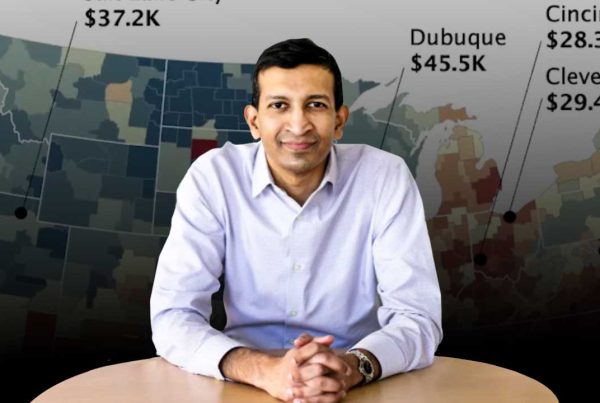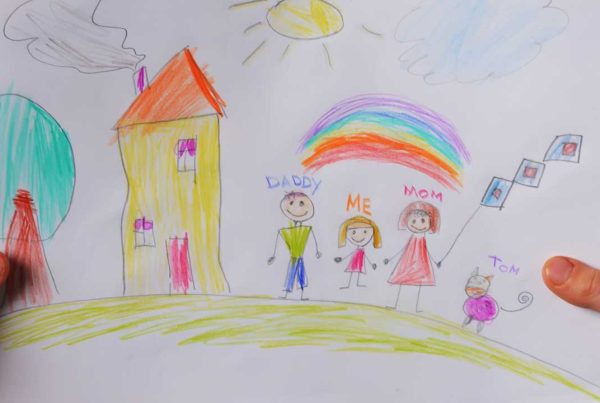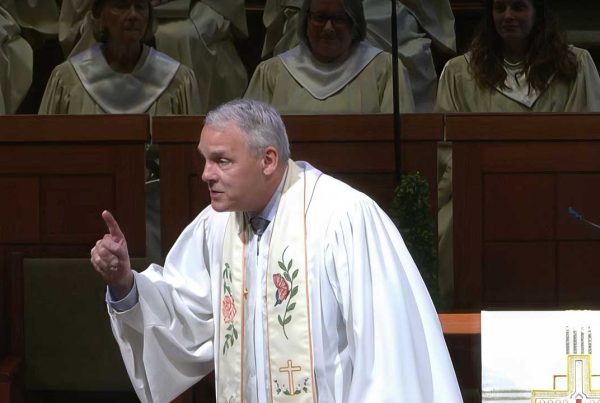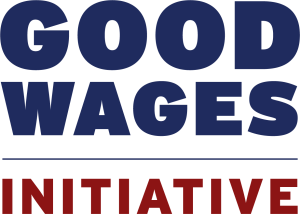Hope is on the horizon
On Oct. 5, Bryan Stevenson spoke to a packed Clowes Auditorium for our Fall 2021 event. Video highlights and lessons learned from Stevenson’s inspiring talk are coming soon!
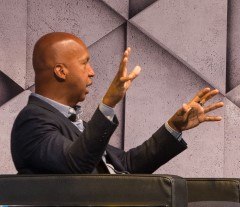
At a CTS gathering earlier this month, the Rev. Dr. Frederick Haynes III painted a vivid and dismal picture of the injustice and poverty that exists all around us. (Learn more about his remarks below.) But the Rev. Dr. Haynes didn’t stop at simply pointing out the sins of our society. He challenged us to take action so that we might embody hope for those who can’t see it themselves.
In hearing that challenge, I found myself thinking: Isn’t it through our faith in the unseen God that we help others see hope?
As we have worked to prepare for our Faith & Action Fall Event on Oct. 5, I’ve been reaching out to local leaders asking what they think will result from the evening with Bryan Stevenson. Many hope that his truth will ignite the community, that his words will bring compassion and hope, and that his message will make us uncomfortable enough to recognize the role we need to play in fighting injustice.
As they shared their thoughts, Rabbi Sandy Eisenberg Sasso and Rabbi Dennis C. Sasso from Beth-El Zedeck Congregation pointed to the need for us to shine light into our community’s dark places. Here is how they put it:
Bryan Stevenson reminds us “to pay attention to the dark.” If we look with open eyes, we see a landscape darkened by hatred and injustice, racism and exclusion. The Hebrew phrase to “pay attention” is sim lev. It means to give your heart; not only to see, but to feel the dark. Only when the dark breaks our heart can we find a way to bring light.
Judaism teaches that we may reach God through many doors. Each one has a unique key. But there is one key that opens every door. Rabbi Menachem Mendel of Kotzk taught, “Nothing is more whole than a broken heart.” With broken hearts, and open eyes, we must bear witness.
The Talmud teaches: “Those in a position to protest the sinful conduct of their town who fail to do so are liable for the sins of the town. Those in a position to protest the sinful conduct of the whole world who fail to do so are liable for the sins of the whole world.” (TB Shabbat 54b) Rabbi Abraham Joshua Heschel challenged us, “In a free society, some are guilty, but all are responsible.”
We need to pay attention, to direct our hearts to compassion unevenly granted, to justice unfairly distributed, to history biasedly told. Then we need to act. More than shame and atonement, we need to cast a new light that will heal the broken heart and make us whole.
Perhaps hope is birthed when we bear witness to the suffering that exists in our community. Perhaps light will prevail when we allow ourselves to walk with our neighbors in the dark places. And perhaps justice will reign when we, as Rabbi Mendel suggests, make our hearts whole by letting them break over the pain of others.
Lindsey Nell Rabinowitch
Director, Faith & Action Project
Inspiring words, calls to action
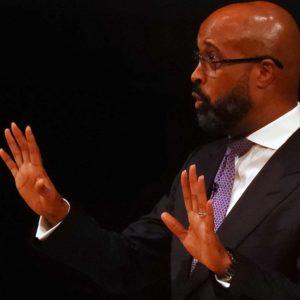 Earlier this month, the Rev. Dr. Frederick Haynes III, a Dallas-based pastor, social activist and orator dedicated to preaching and fighting against racial injustice, brought to a gathering of area faith leaders a message about the importance of engaging and mobilizing congregations to end poverty and injustice. You can listen to his talk here. Following are some “sound bites” to whet your appetite:
Earlier this month, the Rev. Dr. Frederick Haynes III, a Dallas-based pastor, social activist and orator dedicated to preaching and fighting against racial injustice, brought to a gathering of area faith leaders a message about the importance of engaging and mobilizing congregations to end poverty and injustice. You can listen to his talk here. Following are some “sound bites” to whet your appetite:
- “We need hustlers of hope.”
- “If we are serious about dealing with poverty, we must deal with the systems … If we’re not careful, as faith leaders we can spend a lot of time ignoring systems while engaging in service, and to ignore systems while engaging in service will in essence reinforce the systems that produce the necessity for service that you are engaging in.”
- “Poverty means, ‘My options are limited.’”
- “Oftentimes we are guilty of judging persons in poverty for their choices, but we do nothing about their options.”
- “Charity is a sprint race. Justice is a marathon fight.”
- “Violence shows up when people find themselves impoverished.”
Insights to inspire solutions to systemic racism
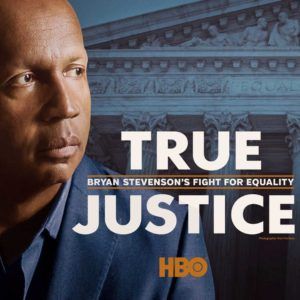 To help broaden the understanding of systemic racism, the Faith & Action Project is offering its community partners a free discussion guide for the Emmy-winning HBO documentary True Justice. Designed to be a catalyst for greater engagement by Indianapolis faith communities, the guide seeks to support conversations that lead to advocacy and action while also building on the messages delivered by Bryan Stevenson’s at the October Faith & Action Fall Event. In order to encourage faith partners to view and discuss True Justice, CTS is offering $200 stipends through the Faith & Action Project to support screenings and discussion sessions. It is our hope that the guide will facilitate robust conversations about the documentary and the lessons it offers about how to effectively oppose racial injustice. To apply for a True Justice stipend and obtain a copy of the discussion guide please click here.
To help broaden the understanding of systemic racism, the Faith & Action Project is offering its community partners a free discussion guide for the Emmy-winning HBO documentary True Justice. Designed to be a catalyst for greater engagement by Indianapolis faith communities, the guide seeks to support conversations that lead to advocacy and action while also building on the messages delivered by Bryan Stevenson’s at the October Faith & Action Fall Event. In order to encourage faith partners to view and discuss True Justice, CTS is offering $200 stipends through the Faith & Action Project to support screenings and discussion sessions. It is our hope that the guide will facilitate robust conversations about the documentary and the lessons it offers about how to effectively oppose racial injustice. To apply for a True Justice stipend and obtain a copy of the discussion guide please click here.
Affordable housing eyed for near downtown
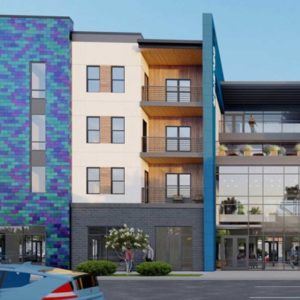 Two projects on the drawing board for Indianapolis would bring affordable housing to near-downtown neighborhoods. Each project is expected to spend roughly $15 million for mixed-use developments focused on housing for those living below or at the areas’ median income. Mapleton Fall Creek Development Corp.’s 56-unit Central@29 would occupy the 2900 block of North Central Avenue and include 14 units for individuals and families experiencing homelessness. Near North Development Corp.’s project at 22nd and Illinois streets would limit rent increases even if a tenant’s income improves. Both projects will include space for wraparound services.
Two projects on the drawing board for Indianapolis would bring affordable housing to near-downtown neighborhoods. Each project is expected to spend roughly $15 million for mixed-use developments focused on housing for those living below or at the areas’ median income. Mapleton Fall Creek Development Corp.’s 56-unit Central@29 would occupy the 2900 block of North Central Avenue and include 14 units for individuals and families experiencing homelessness. Near North Development Corp.’s project at 22nd and Illinois streets would limit rent increases even if a tenant’s income improves. Both projects will include space for wraparound services.
Worth Reading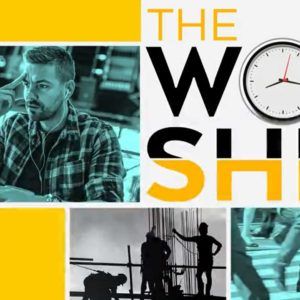
“Minimum Wage Would Be $26 an Hour If It Had Grown in Line with Productivity,” By Aimee Picchi. Pegged at $7.25 for 12 years, the minimum wage has remained level for the longest period since it was adopted in 1938, which means it has dropped far behind the pace of productivity. Had it kept pace, notes CBSNews.com writer Picchi, a minimum-wage worker would earn more than $50,000 a year. Experts Picchi interviewed for her story suggest that the relative drop in wages affects more than workers’ paychecks.
In Marion County, 63% of students qualify for free or reduced-price lunches, the highest county percentage in the state and well above the statewide level of 48%. In neighboring Hamilton and Boone counties, fewer than 20% of students qualify for these subsidies.
Indiana Youth Institute 2021 Indiana KIDS COUNT Data Book


